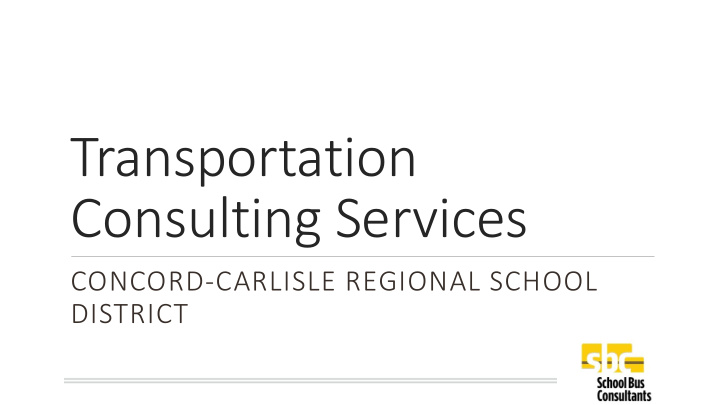



Transportation Consulting Services CONCORD-CARLISLE REGIONAL SCHOOL DISTRICT
Purpose Assist in an assessment of alternative operational models including the analysis and understanding of: The overall viability of outsourced services The advantages (if any) of various alternative outsourcing scenarios The potential for the collaborative use of municipal fleet maintenance facilities The value of the fleet The procurement process and the impact on the results of previous proposals
Baseline metrics for comparison Bas aseline Da Data Number of route buses 32 Number of buses AM 25 Number of buses PM 32 Capacity Utilization 60 percent Average run 39 minutes Average number of runs per bus 5 Estimated annual cost $2,704,000
Service delivery scenarios Sce Scenario A A - Retain Ownership of of Fle Fleet A-1. - Status Quo Start Times of CPS: A-2. - Status Quo Start Time of CCHS: CMS: 8:15 AM to 2:30 PM, ES 8:55 AM to 3:15 PM 7:30 AM to 2:11 PM A-4. - CCHS Stand Alone Start Time with a start time of not A-3. - CPS Stand Alone later than 8:00 AM Sce Scenario B – Sal Sale of of En Entire Fle Fleet B-1. - Status Quo Start Times of CPS: B-2. - Status Quo Start Time of CCHS: CMS: 8:15 AM to 2:30 PM, ES 8:55 AM to 3:15 PM 7:30 AM to 2:11 PM B-4. - CCHS Stand Alone Start Time with a start time of not B-3. - CPS Stand Alone later than 8:00 AM Sce Scenario C - Retai ain Sm Smal all Fle Fleet (pr (proposer to o rec ecommend siz size) C-2. - Status Quo Start Time of CCHS: C-1. - Status Quo Start Times of CPS: CMS: 8:15 AM to 2:30 PM, ES 8:55 AM to 3:15 PM 7:30 AM to 2:11 PM C-4. - CCHS Stand Alone Start Time with a start time of not C-3. - CPS Stand Alone later than 8:00 AM
Results: Scenario B -Sale of the fleet Over a ten-year operational period – Savings of approximately $3,383,000 or as much as 11 percent may be possible. Requirements to achieve savings include: Status quo for school bell times Sale of the fleet Bid cost per bus of approximately $423.57
Results: Scenario A – Retention of the fleet Over a ten-year operational period – Additional costs of approximately $1,096,000 or as much as a 4 percent increase within the current bell time structure. Factors impacting costs: Recurring capital costs Fleet maintenance labor and associated employment costs Parts and supplies
Results: Alternate bell times Over a ten-year operational period – Additional costs of approximately $6,698,000 or as much as a 23 percent increase. Factors impacting costs: Inefficiencies indicative of a two tier system Ineffective use of the fleet assets resulting in approximately 23 additional buses
Results: Scenario C – Retention of a smaller number of vehicles Factors impacting cost savings- Status quo bell times- Recurring capital costs Fleet maintenance labor and associated employment costs Parts and supplies Alternate bell schedule- Inefficiencies indicative of a two tier system Ineffective use of the fleet assets
Results: Assessment of previous bids Bid specifications have a direct impact on the cost of service proposed and on the resulting level of service. Suggestions for future solicitations include: Fully define service parameters and expectations including performance incentives and non-performance penalties Use industry standards to establish fleet mileage and age limits Require all vendors to respond to all sections of the RFB including the purchase of the fleet
Results: Fleet value assessment In general, the bids received for the fleet were reasonable compared against the Yellow School Bus Book values. Difference to to 2013 Yellow School Bid idder/Estimate Resu esults Bus us Book Es Estimate First Student Inc. De-escalated at 3% for 2013 $1,547,829 $304 304,42 429 New England Transit Sales De-escalated at 3% for 2013 $1,049,540 $(193 193,860 860) SBC Calculated Value based on Depreciation $1,611,247 $367 367,84 847 CPS/CCRSD Calculated Value 2012 De-escalated at 3% for 2013 $1,368,185 $124 124,78 785 Yellow Book Analysis 2013 $1,243,400 $0
Results: Fleet value assessment Factors that influence the value received for the purchase of the fleet include: Age and mileage of the current fleet Overall profit potential and margin of the contract The contractors current fleet inventory
Collaborative use of municipal fleet maintenance facilities A properly designed fleet maintenance facility is necessary to support an effective and efficient transportation operation regardless of whether the system is self-operated or outsourced. Elements that are common and necessary include: Approximately 1.5 working bays per fleet maintenance technician A centralized location (to the degree possible) to reduce deadhead time and the associated costs for drivers and fuel Secure parts and supply areas Administrative and support offices
Results: Collaborative use of municipal fleet maintenance facilities Neither the Carlisle or Concord Department of Public Works facilities are readily conducive for bus fleet maintenance without substantial investment in infrastructure and equipment. Examples include: Increase in the number of work bays for mechanics would be required The installation of equipment for safety and efficiency Bus and staff parking Environmental issues such as storm water retention and filtration due to the increase in impervious surfaces
Results: Collaborative use of municipal fleet maintenance facilities The Concord Municipal Light Plant presents a viable opportunity for collaborative services. Modifications to the current facility for fleet maintenance would be minimal including: A re-configuration of the current space to accommodate the creation of a minimum of three work bays for mechanics The installation of equipment for safety and efficiency Dedicated parking for fleet maintenance staff and buses scheduled for repair
Next Steps - Determine if co-location of fleet maintenance services is possible Determine if a permanent parking facility is obtainable Direction on the outsourcing of services The preparation of bid documents
Questions?
Recommend
More recommend